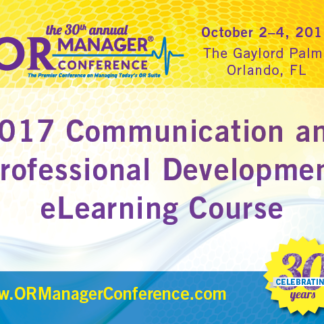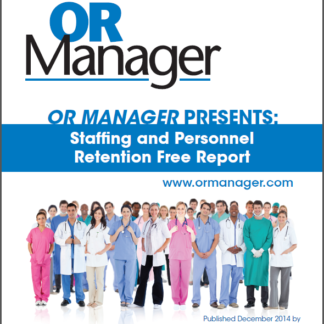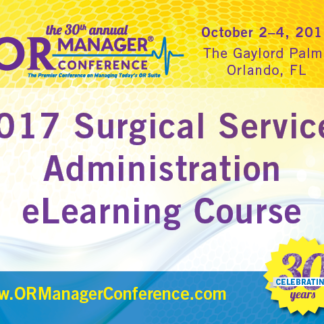Description
This package includes all clinical and education session recordings from the 2022 OR Manager Conference. Earn 6 contact hours upon completion of a post-test.
Presentations include:
- Understanding Health Equity Through Clinical Storytelling
- Implementation of LEAN Visual Management Board Weekly Performance Huddles Result in Ongoing Performance Improvement Success
- A Sticky Situation: Optimizing Collaboration to Eradicate Deep Tissue Pressure Injuries
- Importance of Environmental Conditions During the Transport and Storage of Soiled Medical Devices
- Where are We Now with Surgical Smoke Evacuation Mandates?
- Hands on Education to Develop Your Team: Balancing Resources to Promote Staff Development
Learn more about the sessions:
Understanding Health Equity Through Clinical Storytelling
The quality of patient care is significantly enhanced when culturally empathetic clinicians center their patients’ needs. Narrative reflection, or clinical storytelling, offers a pathway to health equity by prioritizing compassion and the patient’s perspective in delivering patient-centered care. As the pandemic continues to amplify socioeconomic inequities resulting from structural systems that maintain these disparities, narrative medicine exercises help clinicians and students confront their unconscious biases and connect to their practice on a more empathetic and emotional level. In this session, we will discuss historical precedence and the social determinants of health, and focus on how quality care delivery requires that clinicians listen to and respect their patients’ individual narratives, backgrounds, and experiences. We will explore how narrative reflective exercises help clinicians to better understand their patients and themselves, improve relationships, grow personally and professionally, and pursue a more humanistic medical practice.
Implementation of LEAN Visual Management Board Weekly Performance Huddles Result in Ongoing Performance Improvement Success
Visual Management Boards provide the crucial communication of clear processes and expectations necessary to engage and support staff. Utilization of the visual management board provides an avenue for staff to connect their work with performance expectations, view impact and progress, identify where problems lie, determine solutions, demonstrate team appreciation, and celebrate successes. This educational offering will provide the learner with examples of communication components utilized in perioperative visual management boards, demonstrate how the 20 minute weekly visual management board huddle meeting is conducted, and describe our 3-year journey in creating a culture of continuous improvement.
A Sticky Situation: Optimizing Collaboration to Eradicate Deep Tissue Pressure Injuries
Perioperative and cardiothoracic (CT) ICU RNs from a hospital with 1,600 CT and 140 heart/lung transplants per year identified the need to reduce deep tissue pressure injuries (DTPI) by developing a collaborative out-of-the box protocol to prophylactically protect patients’ sacrum prior to surgery.
And because DTPIs result in longer length of stay, increased patient discomfort leading to decreased mobility, decreased patient satisfaction, and higher costs (up to $43,000 per DTPI), RNs recognized an opportunity to develop workflows to improve RN practice and patient care.
The protocol was used for all patients meeting the agreed-upon criteria. There was a significant decrease in the incidence of postoperative sacral DPTIs, from 2.3% to 0%; an estimated 1,510 bed days saved; and estimated $1.4 million dollars saved annually. There have been zero DTPIs within the first five days of surgery, and these results have been sustained since 2016. CT patient satisfaction for RN communication remains at 91.4%. Due to the sustained success in the CT population, this protocol is being implemented for high-risk patients. The innovative strategy to prophylactically reduce DTPI is cost effective and replicable. Keys to success were teamwork, creative thinking, and prioritizing high-quality care.
Importance of Environmental Conditions During the Transport and Storage of Soiled Medical Devices
Point-of-Use treatment is a hot topic. It is such an important part of infection prevention that accreditation surveyors are observing this step after surgical procedures. The central part of point-of-use treatment is to moisten and remove gross soil at the location of use to help prevent organic material and debris from drying on instruments. Dried soil on surgical instrument surfaces can affect the efficacy of subsequent cleaning, disinfection and sterilization processes, and promotes the formation of a dry biofilm. These biofilms are difficult to remove and are more resistant to inactivation by steam sterilization than a hydrated biofilm. The time and transport method from the point-of-use treatment until the thorough cleaning process begins differs from each facility.
In 2021, research was conducted on the solubility of dried soil on reusable medical devices. This groundbreaking research supports the scientific justification for point-of-use treatment and provides guidance for environmental conditions and time constraints when transporting soiled surgical instrumentation. This presentation will show the results of the research project, with data demonstrating the change in solubility of dried soil on reusable medical devices when exposed to various time, temperature, and humidity ranges. These conditions mimic what the device may experience as it is transported from point of use and waiting for decontamination.
Where are We Now with Surgical Smoke Evacuation Mandates?
Surgical smoke hazards and evacuation have been critical issues since the mid-1980s. Even today, nurses continue to advocate for smoke-free environments. This session will relate the evolution of surgical smoke issues and how nursing’s involvement and the impact of state legislation to create smoke-free perioperative environments continue. Effective and creative solutions to ensure the use of proper smoke evacuation devices will be presented along with the difficult task of changing perioperative practices.
Hands on Education to Develop Your Team: Balancing Resources to Promote Staff Development
Simulation is seen as a valuable educational resource to aid in staff development. This form of education takes time and resources. Without leadership support, the execution of simulation and other hands-on learning activities is not possible. Competing demands for time and resources can present challenges in incorporating this hands-on learning into perioperative education plans. Even when dedicating the time needed to run these activities is difficult to find, there are ways to work hands-on learning into your staffing schedule. Learn how one perioperative department has navigated these challenges. Discover ways to balance time and resources to incorporate simulation. Get take-home tools on how this education modality can improve team dynamics and processes.



